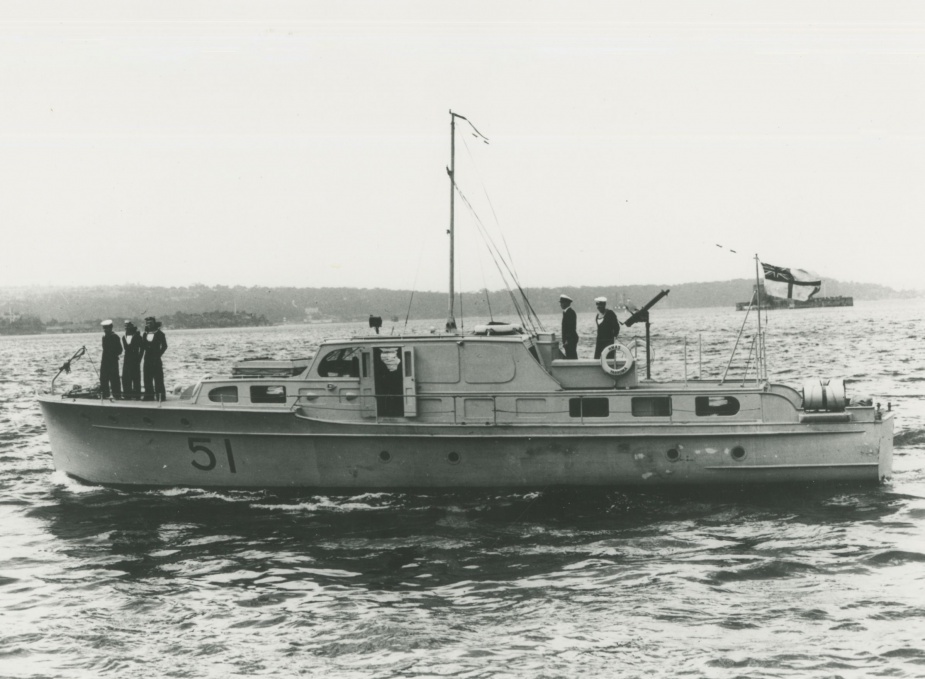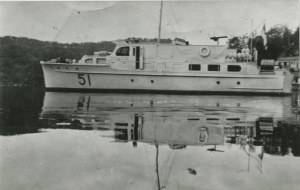
HMAS Yarroma in Sydney Harbour, Fort Denison can be seen in background. Yarroma was present for the miniature submarine attack on Sydney Harbour on 31 May 1942.
The vessel which was to become HMAS Yarroma was built by W L Holmes and Co at McMahon’s Point in Sydney, apparently as the Motor Yacht (MY) Ithaca, launched on 27 June 1939. The owner was a Mr Philip Bevan whose successful machine tool business had amalgamated with McPherson’s Ltd the previous year to form Associated Machine Tools Australia Pty Ltd, manufacturing hand and machine tools such as lathes and grinding wheels, under the McPherson’s banner. The company was instrumental in ensuring the supply of hand and machine tools in Australia during the war years.
Contemporary newspaper articles feature the Bevan family making use of Ithaca off the New South Wales coast up to August 1939, but the yacht’s name appears to have been changed that September to Yarroma. In later negotiations with the Navy Bevan would state that Yarroma had actually been launched on 24 September 1939, however, the evidence does point to Ithaca and Yarroma being one and the same.
Yarroma was requisitioned by the Navy on 20 June 1941 and was commissioned as HMAS Yarroma on 19 August under the command of Lieutenant Sydney Kingsford-Smith, RANVR. In addition to its 2.303 Vickers machine guns and depth charge throwers aft, it was one of the few channel patrol boats fitted with new, and top secret, ASDIC submarine detection equipment.
Following the opening of hostilities with Japan in December 1941 Australian ports intensified their defences, and Sydney became, theoretically, the best defended port in Australia. There were shore-based gun and anti-aircraft batteries scattered about the harbour, Naval Auxiliary Patrol and Channel Patrol Boats in the water, searchlight teams ashore and a small force of fighter aircraft based at Bankstown.
Outside the harbour entrance, lying on the seabed in deep water, 6 indicator loops arced out to sea between Dover Heights in the south to Curl Curl in the north. The loops could detect a large metal object, such as a ship or submarine, passing above. Two more indicator loops were placed inside the harbour, one stretching across the mouth of the harbour between North Head and South Head, the other just inside South Head at Lady Bay across to Middle Head. Additionally, on South Head, was the Port War Signal Station which checked every ship approaching the harbour and, if necessary, ordered any strange or unknown ships to stop until it could be cleared by an examination vessel. Finally, a boom net stretched across the inner harbour between Laings Point on the eastern shore and Georges Head on the western shore.
On the night of 31 May 1942, however, the boom net was not yet completed. At either end, where 2 large gates were still to be constructed, there were 2 gaps some 275 and 293 metres in length respectively. Every night, 2 patrol boats were stationed to guard the net, one at either end where the gates were to be installed. On this particular night the duty vessels were Yarroma at the western end, and HMAS Lolita at the eastern end.
At about 8:15pm, what was thought to be a fishing vessel was observed near the boom net. A Marine Services Board nightwatchman by the name of Jimmy Cargill rowed out in his 14-foot skiff to investigate. Unsure of what it was he was seeing in the water, Cargill rowed over to Yarroma for assistance. With a stoker embarked, he returned to the object where the stoker positively identified it as a submarine. The vessel was a Japanese miniature submarine, the first of 3 miniature submarines to launch an attack in Sydney Harbour that night.
The submarine, M27, had seemingly become entangled in the boom net after passing through the gap at the western end before colliding with the Western Channel Pile Light. Reversing to free herself it backed into the boom net and fouled its propellers. After unsuccessfully attempting to signal the Port War Signal Station, Yarroma eventually made contact directly with Garden Island to report the suspicious object. Garden Island in turn ordered the patrol boat to close on the object and investigate. Yarroma’s Commanding Officer, Sub Lieutenant Harold Eyers, RANVR, however, was reluctant to investigate what he believed may possibly be a mine and risk damaging the top secret ASDIC equipment installed in his vessel. He instead ordered Warrant Officer Herbert Anderson, RANR(S), in Lolita to investigate.
Lolita subsequently carried out 2 depth charge attacks on the stricken submarine, however, the depth charges aboard the channel patrol boats were typically set to detonate at a depth of 100 feet, or about 30 metres. The depth of the water at that location was about 81 feet, or 24 metres. Lolita’s attack did little more than leave 2 unexploded depth charges lying at the bottom of Sydney Harbour.
As Lolita returned to attempt its third attack, it was met by a massive explosion which sent a column of water and flames towering above its. The miniature’s two-man crew, realising the hopelessness of their position, had set off one of the submarine’s 135kg scuttling charges, killing themselves in the process. By this time it was 10:37pm, and the other 2 miniatures had already made their way into the harbour.
Channel patrol boats were soon active in the harbour searching for other submarines. Miniature submarine M24 successfully entered the harbour firing 2 torpedoes at the cruiser USS Chicago, which did not hit their intended target. One ran aground at Garden Island and did not explode, however, the second torpedo struck the sea wall at Garden Island and exploded causing the sinking of the depot ship HMAS Kuttabul, killing 21 sailors (19 RAN and 2 RN) who were sleeping on board. M24 then escaped from the harbour at about 2:05am on the morning of the 1st but subsequently sank off Sydney’s northern beaches after failing to rendezvous with its mother submarine (its wreck was not found until late 2006).
Miniature submarine M22 was first spotted at 3:50am to the north of Garden Island. Channel patrol boats including Lauriana, Lolita, Sea Mist, Steady Hour, Yandra and Yarroma were by then actively searching for the submarines, while several of the warships in port prepared to put to sea rather than risk being torpedoed while at anchor. At around 5:00am Sea Mist entered Taylor Bay to investigate a possible submarine sighting and saw the conning tower of a submerging submarine. Sea Mist dropped 2 depth charges over the site where the submarine had last been seen; however, the second depth charge exploded close to Sea Mist causing damage to its engines and it was forced to break off the attack. Further depth charges were dropped by Steady Hour and Yarroma between 6.40 am and 8.30 am. The attacks by all 3 vessels had effectively disabled M22 which lay on the seabed at Taylor Bay. The miniature submarine’s 2 man crew, knowing that there was no hope of escape, died of self-inflicted revolver shots. M22 was later recovered from the seabed.
Following the miniature submarine attack on Sydney Harbour, Yarroma resumed its regular patrol and harbour duties in and around Sydney. It was transferred to the Naval Auxiliary Patrol on 22 May 1944. It underwent a refit in late 1944 and early 1945 which included the installation of 2 new Hall-Scott (Hudson) 168 Invader engines and engine beds, as well as new water and fuel pipes, exhaust system and propeller shafts. It returned to boom patrol duties in June before being slipped again later in the month to correct defects in its new propeller shafts.
Yarroma decommissioned on 25 August 1945 and, after initially being offered back to Mr Bevan, was sold at auction on 18 December 1945.
 |
| Pennant |
51 |
|---|---|
| Builder |
WL Holmes & Co, Sydney NSW |
| Commissioned |
19 August 1941 |
| Decommissioned |
25 August 1945 |
| Dimensions & Displacement | |
| Length | 58 feet 6 inches |
| Beam | 14 feet 9 inches |
| Draught | 4 feet 3 inches |
| Performance | |
| Speed | 11 knots |
| Armament | |
| Guns | 2 x .303 inch Vickers machine gun |